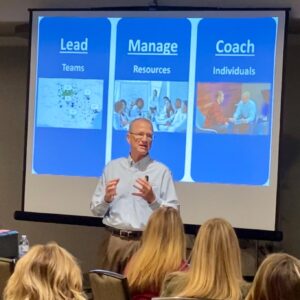Who are “They”?
“They” are those people in corporate…Those salespeople!
The salesperson says, “They don’t get it. I wish “They” understood how hard it is out here! It’s easy to say those things or send an email, but let’s see them come out here and tell my customers that.”
The manager in the corporate office says, “They don’t understand. I wish the sales team would realize how great these products are compared to the competition. Why don’t they sell what we designed and not try to customize, slash prices or sell our products to the wrong customer base?”
The regional manager says, “They don’t understand how hard it is to implement and execute these ideas. You can’t just send an email out of the corporate office and expect it to get done. My salespeople are on the road all day and it’s right in the middle of the busiest time of the year.” In reference to the corporate office.
The regional manager might also be heard saying, “The sales team needs to just get this done. I have enough on my plate. I don’t need to be chasing after them to get their job done!”
Working in agribusinesses for the last 26 years, I’ve heard these or variations of these comments in every business I have been around. Whether you think those comments are said in your company or not, trust me they are.
By nature, agribusiness is spread out across the country. Normally, we have a national headquarters, regional office centers and remote salespeople that interact with farmers, producers, and agribusinesses. As consolidation occurs and local offices are merged into fewer regional offices, we still have to meet the customer face to face at the farm. So, there is still a sales force that is spread out across the nation that operates remotely out of their home office. Even though everyone is on email and has laptops, communication flow and understanding are still a challenge.
With the dispersion of management layers across a large geography and a remote sales team, you can see how hard it might be to understand what other people in your company are going through. If your corporate office is designing products and programs for all of the US, there is a lot of possible scenarios they have to plan for. Now, think about writing those plans or designing those products for all of North America or all of the world locations and salespeople.
No matter where you are: corporate office, regional office, out in your pickup, it’s easy and tempting to make one of the comments from the beginning of this article…. “They don’t know what it’s like to be me and have to face…the customer…the management team….the board of directors….the delivery driver…”
Well, you’re probably right. They don’t know. But, just maybe, you don’t know what they have to face in their everyday life. Do they have good intentions but don’t understand? Do they have good intentions, but poor judgment in getting to those intentions? Have you done your part to “genuinely” help them understand? Firing an angry email reply back at someone is not a genuine way of helping. Trust me, I’ve learned that the hard way.
Try the following techniques to bridge the gaps in your dispersed team. These are steps that can be taken by anyone at any time in the company. You don’t need the title of manager or VP of anything to initiate some of these methods. Take the initiative yourself if you feel “They” don’t understand!
What to do?
1. Empathize or walk in their shoes: I used to think empathy and sympathy were interchangeable words. It wasn’t until I received my Strengths Finders results one day and found out the difference. There are 34 themes in the Clifton’s Strength Finders program. After taking their online assessment, I received my results. Empathy, one of the 34 themes, was my lowest. How could that be? I asked the coach from Clifton. I certainly have the ability to feel sorry for people or can give my condolences when something bad happens to another person. The Clifton coach asked if I knew the difference between sympathy and empathy. I had to admit they seemed like the same thing to me. She went on to explain, empathy is when you can actually feel the pain or suffering that someone is going through. Said another way, Empathy is feeling bad with them. Sympathy is feeling bad for them. Understanding this, I know that I need to actually go see for myself, experience what the other person is experiencing and walk in their shoes as much as possible to truly have an understanding.
How can we do that? Ride alongs or sit with’s. It’s common for someone from the corporate office to come out and spend a day in the field riding with salespeople. That’s great and we need more of it in every company in my opinion. However, the reverse is almost never done. That’s when a salesperson spends time with someone in the corporate office to gain an understanding of what it takes to work in the regional or main office. This can be an eye-opener for those on your sales team that really struggle with the main office. Most of the time, the salesperson returns with a new perspective on life in the corporate or regional world.
2. End with “Why”: You want the sales team to know or do something. Make calls on a specific type of customer…. Report on crop conditions…. Promote this specific product in the next three weeks. To reach dozens or hundreds of field salespeople, you send an email telling them exactly what you want and when you want it done by. Great, but don’t forget to explain the “Why”. I know the temptation is to say, “Because, I said so! That’s why” Fight that temptation and remember that everyone is busy and may not have the big picture understanding that you do. So, take the time to answer a few “Why” questions to establish the impact of doing what you are asking. The first why to explain is “Why now?” Why is it so important to execute these plans right now? Then go into the “Why these customers or why these products right now?” If you are struggling to answer the “why” questions, so will the people in the field. Maybe, it’s not important enough to send.
3. Pick up the phone: Everyone should be aware by now of how poor an email or a text is as a communication tool. Yes, we need to be able to reach large groups quickly and the only way is to broadcast an email to the whole team at once. However, this doesn’t prevent you from picking up the phone or video conference program and having a discussion with some key people. This allows you to add a lot more explanation and context than can be achieved with electronic communication.
While perfection in this area is probably not going to happen in the near future, using some of the methods mentioned above can reduce much of the tension that exists between the corporate office, the regional businesses, and the field sales team. It really does come down to communication and the need to be heard & understood.
I’ll repeat – These are steps that can be taken by anyone at any time in the company. You don’t need the title of manager or VP of anything to initiate some of these methods. Take the initiative yourself if you feel “They” don’t understand!
If you found this to be helpful, forward on to someone you know who might also appreciate it.



